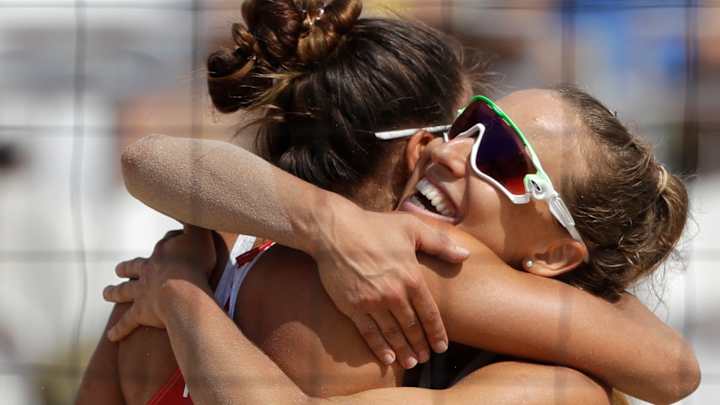New partners hooking up on the Brazilian beach

RIO DE JANEIRO (AP) Think of Olympic beach volleyball like the dance floor of a Rio nightclub: When the samba stops, it's time to start looking for a new partner.
Kerri Walsh Jennings is going for a fourth straight gold medal, but it would be her first with April Ross. Fellow American Phil Dalhausser, who won gold with Todd Rogers in Beijing, is playing with Nick Lucena now (after an unsuccessful dalliance with Sean Rosenthal).
A beach volleyball partnership is often compared to a marriage, and teams all around the world use the years between Olympics to reassess their couplehood.
Some stick together - Walsh Jennings and Misty May-Treanor were the gold standard for three Olympiads - but, sometimes, their eyes can wander.
''It's like high school dating,'' Dalhausser said after beating Tunisia 21-7, 21-13 on Sunday. ''The middle of the pack on the AVP tour, they're always trying to move up. (There are) a lot of guys finding out from other guys they got dumped.''
Walsh Jennings plucked Ross off of the No. 2 U.S. women's pair right there on the sand after the gold medal match in London. (May-Treanor had said she would retire; Ross's partner, Jen Kessy, would be pushing 39 by Rio).
Rogers is now 42, and didn't feel like he had another Olympic run in him. But Dalhausser, who is 36, wanted to give it another try.
''After our last match in London, he was like, `Well, it was nice playing with you.' And I was like, `Yeah, we had a good run,''' Dalhausser said on Sunday. ''So there were no hard feelings there.''
Dalhausser formed what was expected to be a superteam with Rosenthal, himself a two-time Olympian, but it never really clicked. After being knocked out of two straight seasons with injuries, Dalhausser turned to Lucena, a longtime friend he left in 2006 to join up with Rogers.
''That was tough,'' Dalhausser said.
Those aren't the only partner-swappers on the Copacabana sand.
Jake Gibb was with Rosenthal in Beijing and London but is playing in Rio with Casey Patterson. All four Brazilian teams - including the men's and women's world champions, and all of them among the top seeds in Rio - have formed since 2012.
In extreme cases, teams are formed by federations or circumstances: When Viktoria Orsi Toth was bounced from the Rio Games last week after failing a drug test, Marta Menegatti needed a new partner with an Italian passport who met the qualifying requirements.
She had never played with Laura Giombini before the Olympics began.
''Some of the other countries, that have a large pool, you see them switching often,'' said Canadian Heather Bansley, who joined up with indoor volleyball player Sarah Pavan after they each failed to qualify for London.
''In Canada, there aren't a lot of options,'' she said. ''But I think there's a lot of value in sticking together.''
Part of that value is learning each other's tendencies on the court, and how to best communicate and do it under pressure. But the partners also spend so much time together on the world tour that they need to get along off the court, too.
True, there are tales of partners who can't stand each other but stick together for the good of the team. More often, though, the players use a sort of dating period to see how well they match up both on and off the court.
Poland's Monika Brzostek and Kinga Kolosinska have been together since 2009, one of the longest-running partnerships in the tournament.
''We do not have any serious problems. We enjoy each other's company,'' Brzostek said. ''As far as I know, we do not want to change anything.''
Then she looked over to her partner for confirmation.
They both smiled.
''Not for me, either,'' Kolosinska said.
---
Jimmy Golen covers Olympic beach volleyball for The Associated Press. Follow him at: http://www.twitter.com/jgolen .
